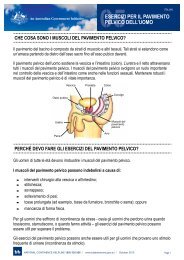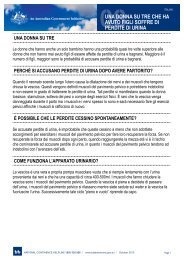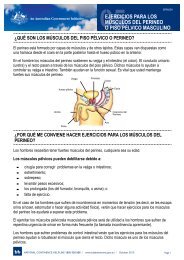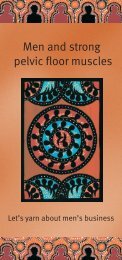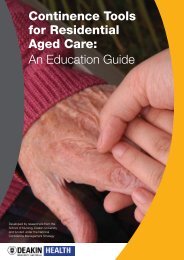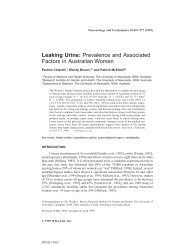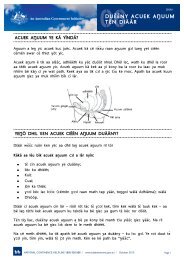Pharmacy Continence Care - Bladder and Bowel Website
Pharmacy Continence Care - Bladder and Bowel Website
Pharmacy Continence Care - Bladder and Bowel Website
You also want an ePaper? Increase the reach of your titles
YUMPU automatically turns print PDFs into web optimized ePapers that Google loves.
predetermined training calendar: monthly sessions that would cover all jurisdictions <strong>and</strong><br />
regions of Australia in a two--year period. It could be expected that the $150 cost to<br />
pharmacies would remain.<br />
Section 5.1.3 outlines the proposed cost for a national implementation of the Program.<br />
Training benefits<br />
As mentioned in Section 3.5.1, a very large majority of pharmacy participants in the PCCP<br />
pilot indicated that they had found the training <strong>and</strong> other trial materials (training pack,<br />
counter talker, BB stickers) useful. The survey results show that the use of materials was<br />
correlated with some additional spending in promoting continence products, possibly<br />
additional sales for smaller pharmacies <strong>and</strong> greater demonstrated knowledge on<br />
incontinence. All respondents to the exit survey indicated that customers were more satisfied<br />
with continence services provided, but this response may be biased as respondents were<br />
more likely to report a positive result here. More encouragingly, 85 per cent of respondents<br />
(27 out of 32 responding pharmacies) indicated that sales of products had increased <strong>and</strong><br />
that there had been an increase in customers seeking continence-related products.<br />
Costs/benefits from cross-referral to other health professionals<br />
The survey of pharmacies found a strong result in favour of net benefits from referrals<br />
to/from other health professionals. Additional cross-referrals were not felt likely to involve<br />
extra costs for pharmacies. The vast majority of pharmacies (82 per cent <strong>and</strong> 87.5 per cent<br />
in initial <strong>and</strong> exit surveys respectively) said there were no costs from referrals from other<br />
health professionals. A similar proportion – 84 per cent – said that the pharmacies were<br />
unlikely to incur cost as a result of referring customers to other health providers.<br />
A slight increase of respondents in the exit survey (81 per cent vs. 73 per cent in the initial<br />
survey) said that the pharmacy was likely to gain from cross-referrals. The types of gain<br />
mentioned in the surveys included: “extra customers”, “increased goodwill <strong>and</strong> increased<br />
professional <strong>and</strong> assistant satisfaction”, “improved service <strong>and</strong> care”, “increased sale of<br />
incontinence products”, “loyalty from customers”, “raises the pharmacy’s profile”.<br />
4.3 Outcomes for consumers<br />
Ipsos Australia Pty Ltd (incorporating TQA Research) was commissioned by Nova Public<br />
Policy to conduct an evaluation by survey of the consumer experience of the <strong>Pharmacy</strong><br />
<strong>Continence</strong> <strong>Care</strong> Program.<br />
The evaluation consisted of two surveys:<br />
• baseline survey of consumers (target 500; n=45) recruited by pharmacies. Each<br />
consumer who consented to be part of the trial was issued a printed questionnaire,<br />
together with a printed reply-paid envelope addressed to Ipsos. This questionnaire<br />
incorporated the Incontinence Impact Questionnaire, a scientifically validated instrument<br />
used for measuring the impact of continence care. Completed questionnaires were<br />
returned directly to Ipsos to protect respondent confidentiality<br />
• follow-up telephone survey of 30 consumers from the 45 who initially responded. This<br />
survey used the same questionnaire as in the baseline survey, with some minor<br />
amendments to tense <strong>and</strong> additions in respect of post intervention issues.<br />
The project team suggest that it is difficult to to encourage people to talk about<br />
incontinence. National data has affirmed that there continues to be a great deal of stigma<br />
<strong>and</strong> reticence attached to this condition. This project has encountered this difficulty. NOVA<br />
Final Report<br />
38<br />
NOVA Public Policy<br />
<strong>Pharmacy</strong> <strong>Continence</strong> <strong>Care</strong> Project



